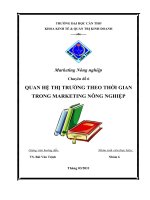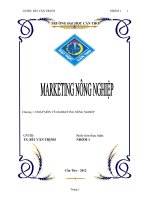Discussion question marketing nông nghiệp (VNUA)
Bạn đang xem bản rút gọn của tài liệu. Xem và tải ngay bản đầy đủ của tài liệu tại đây (103.28 KB, 8 trang )
Discussion question: CHAPTER 1
1. How would you explain food marketing to someone who is unfamiliar with this
subject?
First of all, Food marketing means different things to different people (consumer,
farmer, middlemen etc.)
We will define food marketing as the performance of all business activities involved in
the flow of products and service from the point of initial agriculture production until
they are in the hands of customers.
For example, fifty-six companies are involved in making one can of chicken noodle
soup. These businesses include not only chicken and vegetable processors but also the
companies that transport the ingredients and those who print labels and manufacture
cans. The food marketing system is the largest direct and indirect non-government
employer in the United States.
2. Some people associate food marketing with everything that happens outside the
farm gate? Do you agree or disagree?
It is disagreed that food marketing with everything that happens outside the farm gate
because food marketing as the performance of all business activities involved in the flow
of products and service from the point of initial agriculture production until they are in
the hands of customers.
There is no doubt that marketing begins with production decisions on the farmer and the
firm, what kind of tree should farmer plan, how much to produce, how to produce, and
how to distribute the production, How the product package and how they come to
customer hands.
Finally, this is all reason for us to believe that food marketing is everything happens
inside and also outside the farm gate.
3. What does this mean to say that farmers and food marketing firms are mutually
interdependent?
There is no doubt that farmers and food marketing firms are mutually interdependent
because marketing begins with production decisions on the farm.
Specifically, farmers want the highest possible returns from the sale of their products.
They want their food to be solved with the highest profit and want to introduce it to
customer to let them know about their product. And foods marketing middlemen or firm
seek to earn the greatest profit possible for farmer , for detail they package farmer food,
make marketing strategy to introducing farmer’s product to customer, transfer it to
customer . In addition, the farmer also bring food marketing firm benefit from solve
food for farmer
So it is so true to say that farmers and food marketing firms are mutually interdependent.
4. How to improve transportation and communication influence the food marketing
process?
Nowadays, there are so many way to improve the influence of transportation and
communication in food marketing process
Because of the trends in agriculture, to a large extent, are the result of advancing
technologies likes transportation technology -- combining an awareness of potential
buyers with the ability to deliver to them, producers begin to recognize an opportunity
for additional demand. Thus information and transportation technologies have added
consumers to the producer's market. Consumers can use a similar combination of
information and transportation to increase the number of suppliers they can access.
There is no doubt that without effective marketing communications the consumer
remain unaware of products and services they need, who might supply them and the
benefits which both product and suppliers can offer. Moreover, it is impossible to
develop effective and efficient marketing systems without first establishing channels of
communication. Even the best products do not sell themselves. Marketing
communications serve five key objectives:
the provision of information
the stimulation of demand
differentiating the product or service
underlining the product's value,
regulating sales.
Marketing communications takes four forms - advertising, sales promotion, personal
selling and publicity. These must be formulated within a co-ordinated marketing
communications plan. If there is more than one target market then there will need to be
more than one communications programmer. Like all other elements of the marketing
mix, it must be tuned to the characteristics and needs of the target market.
So how to develop a marketing communications program ?
Once the overall marketing strategy has been determined and the marketing plan has
been outlined, it is necessary to develop a set of operational communication objectives.
It is only when this is done that an appropriate marketing communications mix can be
designed. There are, however, a number of intervening factors to be considered before
the communications mix is finalized. These include the nature of both the product and
the market, the stage at which the product lies in its life cycle and the relative value of
the product in terms of its price to potential purchasers. Having decided upon the
communications mix, the promotional message can be determined and the medium or
media best suited to delivering this message can be chosen. At this point, the budgetary
implications of the decisions made so far have to be considered. If the cost of the
communications program exceeds the resources available to the organization, then there
may have to be an adjustment in the communications mix. In some instances, the
organization may conclude that it can adjust the communications mix to reduce the cost
to an affordable level but that the revised communications package is unlikely to achieve
the original objectives. Faced with this situation, the organization may resort to revising
its marketing communications objectives. Once the budget has been set the program can
be implemented. The effectiveness of the program has to be measured against its
objectives and, if necessary, adjustments or wholesale revisions of the program will be
made.
Be Authentic, have a Conversation, Create Buyer Personas, Provide Relevant Content,
Focus on Quality Engagement Over Quantity,
Finally be helpful.
Discussion question: CHAPTER 2
1. Can you think of any food marketing activities not included in the list of marketing
function provides in this chapter?
There are some activities like market research, consumer’s behavior research, food trend
research.
2. Comment on the meaning of statement “you cannot eliminate the middleman”
Under what circumstances can middle man be eliminate?
It’s a commonly believed that you cannot eliminate the middleman.
In most caces this statement is true because you cannot eliminate the middleman
producers especially in food market farmers want the highest possible returns from the
sale of their products and middlemen seek to earn the greatest profit possible,
middleman distribute the product to large area, make the product flow from producers to
consumers. We have found that the core function of intermediaries is to deliver goods to
the consumers when and where they want them. To achieve this, they buy the products
from the producers, store them as they search for viable markets, and then transport
them to the consumers. In the process, they assume any risks facing the goods -- for
instance, theft, perishability and other potential hazards. In addition, middlemen promote
the goods to the consumers on behalf of the producers. Specifically, Intermediaries are
very important players in the market. Both the consumers and producers gain immensely
from the roles of middlemen, who ensure that there is a seamless flow of goods in the
market by matching supply and demand. Intermediaries provide feedback to the
producers about the market, thus influencing the decisions made by the manufacturers.
Buyers, on the other hand, gain from the services offered by intermediaries, such as
promotion and delivery. Buyers can get the right quantity they want, as intermediaries
are able to sell in small units. Middleman is an important element in the whole
production-distribution-consumption process.
But in some cases middleman can be eliminate. With some products is can be preserve a
long time. Easily to transfer to customer, like industrial product. Or the best way to
eliminate middleman it is using the new way to distribute product. For example using
Internet (click and mortal), to bring all information of product to consumers, and solve it
without going through middleman.
3. How farmer and consumers decide which of the marketing function to perform for
themselves?
Marketing is sometimes thought of as simply the process of buying and selling. Its tasks
are much more extensive than this simple description. For a marketing system to be
operative and effective, there are three general types of functions which it must provide.
· Exchange functions:
- buying
- selling
- pricing.
· Physical functions:
- assembling
- Transport and handling
- Storage
- Processing and packaging
- Grading and standardization.
· Facilitating functions:
- Financing and risk-bearing
- Market information
- Demand and supply creation
- Market research.
Exchange functions are what is commonly thought of as marketing. They involve
finding a buyer or a seller, negotiating price and transferring ownership (but not
necessarily physical transfer). These functions take place at the "market" - that is, the
physical meeting point for buyers and sellers at the point of production or via some other
means of communication. At this point, formal or informal property rights are important
to ensure the reliable transfer of ownership and to guarantee legality (e.g. those animals
on sale were not stolen and will not be reclaimed).
Physical functions enable the actual flow of commodities through space and time from
producer to consumer and their transformation to a form desirable to the consumer.
Assembling or concentrating the product at convenient points allows its economical
transport (i.e. getting enough animals together to transport cheaply). This is a valuable
function which is often overlooked in the public perception of traders. Storage allows
the commodity to be held until peak season demand, thereby stabilizing supply.
Processing transforms the commodity into the products desired by the consumers.
Grading and standardization allow the consumer to be more confident of the
characteristics of the good being purchased.
Financing and risk-bearing are two important facilitating functions. The owner of goods
at any marketing stage must sacrifice the opportunity to use the working capital needed
to buy those goods elsewhere. Or the owner must borrow that capital. In either case,
capital must be provided by the trader or by some lending source. Regardless, cost is
involved. Further, there is an implicit cost in the risk of losing all or part of that capital
through theft, spoilage, mortality or changing market conditions. Without the willingness
to provide the capital and to bear these costs, no stage of the market chain could
function. Other facilitating functions enable producers to respond to consumer needs and
thus provide goods in the locations, quantity and form desired.
These functions create the marketing environment, whose elements are:
· Market and facilities - including the entire physical infrastructure that a market may
depend on.
· Market information and intelligence - including informal and formal communication
systems, and standard weights and grades on which market information depends.
· Institutional environment - including the government policy environment, regulations
and supporting legislation.
In conclusion, for all reason above to decides the performance function farmer and
consumer must depend on the product they produce, or want to buy. How the product go
to consumers or to be produce, including informal and formal communication systems,
and standard weights and grades on which market information depends.
4. Why are there so many different kinds of food marketing institution?
Because increasing sales and expanding a farming operation maybe more difficult than it
sounds. While farmer market or truck stands might be viable option for some, most
people purchase their food from grocery, stores, restaurants or other outlets. If sales of
locally frown food are to increase, farmer need to break into new market so they need
new, and different kind of marketing institution.
5. How sovereign are food consumers? Increase or decrease?
CONSUMER SOVEREIGNTY:
The notion that consumers ultimately determine what goods and services are produced
and how the economy's limited resources are used based on the purchases they make.
Consumers thus reign over the economy as sovereign rulers.
Like most notions this one captures an essential dimension of economic behavior, but it
also has a notable qualification.
Consumers are King
Consumer sovereignty means that buyers ultimately determine which goods and services
remain in production. While businesses can produce and attempt to sell whatever goods
they choose, if the goods fail to satisfy the wants and needs, consumers decide not to
buy. If the consumers do not buy, the businesses do not sell and the goods are not
produced.
Suppose, for example, that Manny Mustard's House of Sandwich introduces a new menu
item--a sandwich made with fried squash, sweet pickle relish, blue cheese dressing,
sliced cabbage, and pumpernickel bread. Manny, the proprietor of this establishment,
thoroughly enjoys this sandwich and thinks his patrons will as well. If they do, then
business increases, profits are higher, overdue business loans can be paid off, and he can
finally send his unruly step-son away to military school.
Manny's business success, however, depends on his patrons. Will they like his new fried
squash, sweet pickle relish, blue cheese dressing, sliced cabbage, pumpernickel bread
sandwich? If they do not, then his step-son will continue his unruly behavior. The
consumers are king! They ultimately decide Manny's business fate.
Consumers as Pawns
Consumers are sovereign as long as they know what they want and are able to act upon
their desires. If consumers are tricked or fooled into making purchases that do not satisfy
their wants and needs due to limited information or deceitful business practices, then
consumers might not be the rulers of the economic realm. They might be pawns.
Consider the case of Curious Curt's Curio Corner. The Curio Corner sells nick-knacks,
jewelry, posters, and assorted novelty items. Curt's latest novelty offering is a magnetic
mood pendant purported to improve the wearer's state of mind and outlook on life and it
sells for only a dollar. The Curio Corner's marketing efforts are boosted by an intense
advertising campaign promoting the psychological benefits of the magnetic mood
pendant.
Millions of consumers hear about the magnetic mood pendant and are swayed
sufficiently by the advertising to give it a try. After all, it only costs a dollar.
Unfortunately the magnetic mood pendant has no impact on state of mind or outlook on
life. It is just a magnet. It does not work. It does not really do anything. Deluged by
advertising consumers buy. Millions believe it works. But it does not. And sales of the
magnetic mood pendant persist. Gullible consumers keep buying. Curious Curt
continues to sell. But it does not work. It does not provide the consumer satisfaction that
buyers expect. Consumers are not king. They are pawns.
Discussion question: CHAPTER 3
It is sometimes argued nutrition is the most importance factor in buying food. I partly
agree with the opinion
One the one hand, I agree that nutrition is one of the core value for us to make decision
before buying food. It’s the nutritional choices that we make every day that will
determine how healthy we will be in the long run. Too much food can make us obese,
while too little nutrition can lead to malnourishment. The right foundation to good health
is to choose food products that are rich in nutrients and have a balanced amount of
nutrients like vitamins, minerals, protein, carbohydrates and a little bit of fat as well. If
you choose your foods wisely, you will be able to enjoy the experience of eating, as the
right foods will help you remain healthy.
On the other hand, I do not think that nutrition is the most importance factor. Like I said
before Nutrition is just one of core value to choose what should we buy. But it’s not the
most importance thing. Because, belong to the opinion of different people with different
income and sometime is just different knowledge about food nutrition balance with
dealing with hunger, creating the most importance factor in buying food. For example
people with very low income in not development country the most important factor for
them may be very simple it’s dealing with their hunger every daily meal.
Conclusion, I only partly agree with this argue. Because everybody have different
opinions and views personally about nutrition and the most important factor in buying
food and we need to respect it.









